The San Francisco Law Library maintains a comprehensive Law Practice Management Collection, with publications that detail all aspects of opening a practice—hanging your shingle, billing, marketing, risk management, technology, and more. This post introduces the Law Library’s LPM resources that help lawyers strategize about the financial health of their firm.
Stay tuned for future installments that highlight the Law Library’s materials on additional LPM topics.
The Business Guide to Law: Creating and Operating a Successful Law Firm, by Kerry M. Lavelle. American Bar Association, Solo, Small Firm, and General Practice Division, 2015.
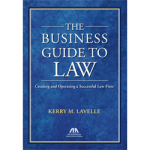 Each topic included in this comprehensive guide is discussed from the perspective of how it impacts the bottom line. By adopting this unique approach, you will develop a shrewd sense of business savvy as you tackle the day-to-day operations of your law practice. Author Kerry M. Lavelle also stresses that in order to truly thrive, a law firm needs to do more than merely turn a profit—it needs to have a winning culture. A focus on the firm’s defining purpose or ideology plants the seeds for a visionary culture, which is the foundation of the firm’s financial success.
Each topic included in this comprehensive guide is discussed from the perspective of how it impacts the bottom line. By adopting this unique approach, you will develop a shrewd sense of business savvy as you tackle the day-to-day operations of your law practice. Author Kerry M. Lavelle also stresses that in order to truly thrive, a law firm needs to do more than merely turn a profit—it needs to have a winning culture. A focus on the firm’s defining purpose or ideology plants the seeds for a visionary culture, which is the foundation of the firm’s financial success.
Lawyer Finances: Principles and Practices for Personal and Professional Financial Success, by Nelson P. Miller, Mark A. Michon, and Paul T. Sorensen. Vandeplas Publishing LLC, 2014.
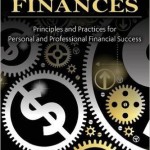 Most resources on law firm finances ignore the role that a lawyer’s personal finances play in ensuring professional success. Accordingly, this book covers both topics in turn, with the understanding that sound personal finances are the underpinning of healthy professional finances. Personal finance topics cover everything from budgeting and insurance to investment and retirement planning. Topics in professional finance include capital structures, financial plans, operating statements, and much more.
Most resources on law firm finances ignore the role that a lawyer’s personal finances play in ensuring professional success. Accordingly, this book covers both topics in turn, with the understanding that sound personal finances are the underpinning of healthy professional finances. Personal finance topics cover everything from budgeting and insurance to investment and retirement planning. Topics in professional finance include capital structures, financial plans, operating statements, and much more.
The Lawyer’s Guide to Increasing Revenue, with CD-ROM, by Arthur G. Greene. American Bar Association, Law Practice Management Section, 2nd ed., 2011.
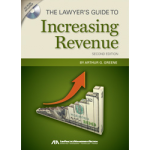 With profit margins tightening across the legal industry, many law firms jump to cut costs. But a year or two of cost cutting undermines growth capacity so significantly that it may be too late to turn the firm around and generate profit. Look beyond stop-gap solutions and develop a revenue mindset instead. This book sets out a step-by-step plan to evaluate and strategize about your firm’s finances, along with sample policies and worksheets to get you started.
With profit margins tightening across the legal industry, many law firms jump to cut costs. But a year or two of cost cutting undermines growth capacity so significantly that it may be too late to turn the firm around and generate profit. Look beyond stop-gap solutions and develop a revenue mindset instead. This book sets out a step-by-step plan to evaluate and strategize about your firm’s finances, along with sample policies and worksheets to get you started.
Minding Your Own Business: The Solo and Small Firm Lawyer’s Guide to a Profitable Practice, with CD-ROM, by Ann M. Guinn. American Bar Association, General Practice, Solo & Small Firm Division, 2010.
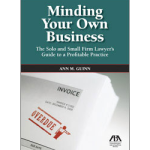 A seasoned consultant to solo and small firms, author Ann M. Guinn emphasizes the importance of several metrics that are often overlooked when gauging a law firm’s financial health—how long it takes clients to pay their bills, the firm’s liquidity ratio, and the overhead-to-expenses percentage. She also confronts common self-limiting behaviors and personal habits that thwart a firm’s financial success, and mines from her consulting experience to give numerous examples of unwise financial management decisions to avoid.
A seasoned consultant to solo and small firms, author Ann M. Guinn emphasizes the importance of several metrics that are often overlooked when gauging a law firm’s financial health—how long it takes clients to pay their bills, the firm’s liquidity ratio, and the overhead-to-expenses percentage. She also confronts common self-limiting behaviors and personal habits that thwart a firm’s financial success, and mines from her consulting experience to give numerous examples of unwise financial management decisions to avoid.
Survival Guide to Implementing Effective Law Firm Management Strategies, by Arthur G. Greene and Sandra J. Boyer. American Bar Association, Law Practice Division, 2015.
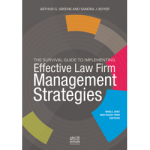 This book’s Financial Management section takes big law financial reporting and scales it to the meet concerns of small and mid-sized law firms. It urges that lawyers should not succumb to the temptation to outsource financial reporting to a bookkeeper, but instead must oversee the process so that all valuable data is gathered. The chapter on paralegal profitability is essential reading for a growing law firm, as it breaks down the cost comparison of hiring a paralegal instead of an associate.
This book’s Financial Management section takes big law financial reporting and scales it to the meet concerns of small and mid-sized law firms. It urges that lawyers should not succumb to the temptation to outsource financial reporting to a bookkeeper, but instead must oversee the process so that all valuable data is gathered. The chapter on paralegal profitability is essential reading for a growing law firm, as it breaks down the cost comparison of hiring a paralegal instead of an associate.
About the author:
Andrea Woods is a Reference Librarian at the San Francisco Law Library.


